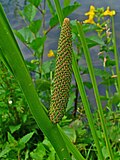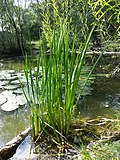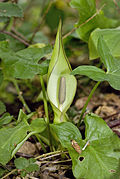List of alismatid families
| Flowering plant families (APG IV) | |||||
|---|---|---|---|---|---|
|
|
|||||
| Early-diverging flowering plants | |||||
| Monocots: Alismatids • Commelinids • Lilioids | |||||
|
|
|||||
Eudicots
|
The alismatid monocots are a group of 15 interrelated families of flowering plants, named for their largest order, Alismatales.[a] Like other monocots, they usually have a single embryonic leaf (cotyledon) in their seeds, scattered vascular systems, leaves with parallel veins, flowers with parts in threes or multiples of three, and roots that can develop in more than one place along the stems.[6] The alismatids have adapted to thrive in oceans, temperate zones, deserts, the tropics, and even glacial regions.[7]
Like the earliest monocots, many of the alismatid monocots are aquatic, and some grow completely submerged. Apart from the sweet-flag family of wetlands plants, all the alismatid families are in Alismatales. Some of the plants in this order are invasive aquatic weeds that can disrupt and destabilize ecosystems. Others grow in a variety of habitats, especially plants in the aroid family. This family includes the titan arum, with the world's largest unbranched inflorescence, and also the world's smallest flowering plant, duckweed.[2][5][8][9]
Glossary[edit]
From the glossary of botanical terms:
- annual: a plant species that completes its life cycle within a single year or growing season
- basal: attached close to the base (of a plant or an evolutionary tree diagram)
- climber: a vine that leans on, twines around or clings to other plants for vertical support
- herbaceous: not woody; usually green and soft in texture
- perennial: not an annual or biennial
- woody: hard and lignified; not herbaceous[10]
The APG IV system is the fourth in a series of plant taxonomies from the Angiosperm Phylogeny Group.[2] In this system, the alismatids are basal within the monocots.[8][11]
Alismatid families[edit]
| Family and a common name[12][b] | Type genus and etymology[c] | Total genera; global distribution | Description and uses | Order[14] | Type genus images |
|---|---|---|---|---|---|
| Acoraceae (sweet-flag family)[15] |
Acorus comes from a Latin plant name.[16][17] | 1 genus, in North America, Europe and Asia[15][18] | Herbaceous aromatic plants with thin, sword-shaped leaves. The rhizomes are essentially non-vascular.[15] | Acorales | |
| Alismataceae (water-plantain family)[19] |
Alisma comes from a Greek plant name.[20][21][22] | 18 genera, worldwide[23] | Herbaceous latex-bearing aquatic plants, usually perennials. They take root in freshwater beds, and some remain submerged.[19][24] Two species are consumed in Asia, and another was a food source for Native Americans.[19][24] C4 photosynthesis[d] has been observed in Sagittaria.[8] | Alismatales | |
| Aponogetonaceae (waterblommetjie family)[25] |
Aponogeton is from the Latin for "near (the hot springs at) Aponus".[26] | 1 genus, in Africa, Oceania, and South and Southeast Asia[25][27] | Herbaceous smooth-stemmed freshwater perennials, usually with long leaf-stalks.[28] Cape pondweed flowers are consumed as a delicacy in South Africa; the tubers are also edible.[25] | Alismatales | |
| Araceae (aroid family)[29] |
Arum comes from a Greek plant name.[30][31][32] | 142 genera, worldwide, especially in the tropics[33][34] | Generally sappy, herbaceous plants growing in soil, in water and on trees, along with a few woody climbers. Many cultures have relied on taro plants (which are toxic when raw) as a staple crop.[33][35] | Alismatales | |
| Butomaceae (flowering-rush family)[36] |
Butomus is from the Greek for "ox-wounding", named for the sharp leaves.[37][38] | 1 genus, in temperate Europe and Asia[36][39] | Smooth-stemmed herbaceous aquatic, swamp or marsh plants, usually with milky latex.[40] They are consumed in parts of Russia, in bread or as a vegetable.[36] | Alismatales | |
| Cymodoceaceae (turtle-grass family)[41] |
Cymodocea was named for Cymodoce, a Greek sea nymph.[42][43] | 6 genera, in tropical and warm temperate seas[41][44] | Large perennials,[41] up to 30 cm (12 in) long in the genus Cymodocea.[45] They nourish and shelter many crustaceans and fish that are harvested commercially.[41] | Alismatales | |
| Hydrocharitaceae (frogbit family)[46] |
Hydrocharis is from the Greek for "water grace".[47][48] | 14 genera, worldwide[46][49] | Annual and perennial aquatic plants. One species is consumed in Asia. Many invasive genera have become entrenched, causing considerable economic damage.[46] | Alismatales | |
| Juncaginaceae (arrowgrass family)[50] |
Juncago (an earlier synonym for the type genus, Triglochin) is from the Latin for "a rush-like plant".[50][51] | 3 genera, in northern temperate zones, South America, Oceania and parts of Africa[50][52] | Herbaceous plants with grass-like leaves that grow in soil or water.[50][53] Two species are edible.[50] | Alismatales | |
| Maundiaceae (Maund's-arrowgrass family)[54] |
Maundia was named for John Maund (1823–1858), a physician and chemist.[55] | 1 genus, in eastern Australia[54][56] | Aquatic perennials with leaves up to 80 cm (31 in) long. The family is likely to become endangered as water tables recede in eastern Australia.[54] | Alismatales | |
| Posidoniaceae (tapeweed family)[57] |
Posidonia was named for Poseidon, a Greek god.[58] | 1 genus, in the Mediterranean and oceans south and west of Australia[57][59] | Submerged plants with long linear leaves. Genetically identical beds of Posidonia oceanica in the Mediterranean can be kilometers wide and persist for many thousands of years.[57] | Alismatales | |
| Potamogetonaceae (pondweed family)[60] |
Potamogeton comes from Greek and Latin plant names.[61][62] | 5 genera, worldwide[60][63] | Aquatic plants, usually perennials.[60][64] The plants are an important food source for many birds and aquatic animals.[60] | Alismatales | |
| Ruppiaceae (tasselweed family)[57] |
Ruppia was named for Heinrich Bernhard Ruppius (1688–1719).[65] | 1 genus, scattered worldwide, in ponds, marshes and shallow seas[57][66] | Submerged herbaceous plants, usually annuals with stalkless leaves[57][67] | Alismatales | |
| Scheuchzeriaceae (Rannoch-rush family)[68] |
Scheuchzeria was named for Johann Gaspar Scheuchzer (1684–1738) and his brother Johann Jacob.[69] | 1 genus, in arctic sphagnum bogs[68][70] | Perennial aquatic plants. The linear leaves have parallel veins.[68] | Alismatales | |
| Tofieldiaceae (false-asphodel family)[71] |
Tofieldia was named for Thomas Tofield (1730–1779).[72][73] | 4 genera, mostly in northern boreal and montane zones, with some species in the US, China and Japan[71][74] | Herbaceous rhizomatous perennials, usually with leaves attached at the plant's base[71][75] | Alismatales | |
| Zosteraceae (eelgrass family)[76] |
Zostera is from the Greek for "belt".[76][77] | 2 genera, in temperate and subtropical sea beds[76][78] | Perennials with simple leaves.[76][79] The plants have been used as packing material. The dense growths support commercially important fish and shrimp.[76] | Alismatales |
See also[edit]
Notes[edit]
- ^ The taxonomy (classification) in this list follows Plants of the World (2017)[1] and the fourth Angiosperm Phylogeny Group system.[2] Total counts of genera for each family come from Plants of the World Online.[3] (See the POWO license.) Extinct taxa are not included. The monocots as a whole are the plants responsible for most of the global agricultural output, including those in the grass, palm, banana, ginger, asparagus, pineapple, sedge and onion families.[4][5]
- ^ Each family's formal name ends in the Latin suffix -aceae and is derived from the name of a genus that is or once was part of the family.[13]
- ^ Some plants were named for naturalists (unless otherwise noted).
- ^ See Photosynthesis#C3 : C4 photosynthesis research for the chemistry of C4 photosynthesis.
Citations[edit]
- ^ Christenhusz, Fay & Chase 2017.
- ^ a b c Angiosperm Phylogeny Group 2016.
- ^ POWO.
- ^ Givnish et al. 2010, p. 585.
- ^ a b Royal Botanic Gardens.
- ^ Christenhusz, Fay & Chase 2017, pp. 115–116.
- ^ Christenhusz, Fay & Chase 2017, pp. 115–131.
- ^ a b c Stevens 2023.
- ^ Christenhusz, Fay & Chase 2017, pp. 117–120.
- ^ Christenhusz, Fay & Chase 2017, pp. 638–670.
- ^ Christenhusz, Fay & Chase 2017, pp. 10, 117.
- ^ Christenhusz, Fay & Chase 2017, pp. 117–131.
- ^ ICN, art. 18.
- ^ Stevens 2023, Summary of APG IV.
- ^ a b c Christenhusz, Fay & Chase 2017, p. 117.
- ^ Coombes 2012, p. 30.
- ^ Stearn 2002, p. 30.
- ^ POWO, Acoraceae.
- ^ a b c Christenhusz, Fay & Chase 2017, p. 122.
- ^ Coombes 2012, p. 36.
- ^ Stearn 2002, p. 38.
- ^ IPNI, Alismataceae, Type.
- ^ POWO, Alismataceae.
- ^ a b POWO, Alismataceae, Flora of Tropical East Africa.
- ^ a b c Christenhusz, Fay & Chase 2017, p. 126.
- ^ Stearn 2002, p. 48.
- ^ POWO, Aponogetonaceae.
- ^ POWO, Aponogetonaceae, Flora of Somalia.
- ^ POWO, Araceae, Neotropikey.
- ^ Coombes 2012, p. 52.
- ^ Stearn 2002, p. 53.
- ^ IPNI, Araceae, Type.
- ^ a b Christenhusz, Fay & Chase 2017, pp. 118–120.
- ^ POWO, Araceae.
- ^ POWO, Rapateaceae, Flora of West Tropical Africa.
- ^ a b c Christenhusz, Fay & Chase 2017, p. 123.
- ^ Coombes 2012, p. 72.
- ^ Stearn 2002, p. 73.
- ^ POWO, Butomaceae.
- ^ POWO, Butomaceae, Flora of Tropical East Africa.
- ^ a b c d Christenhusz, Fay & Chase 2017, p. 131.
- ^ Burkhardt 2018, p. C-77.
- ^ IPNI, Cymodoceaceae, Type.
- ^ POWO, Cymodoceaceae.
- ^ POWO, Cymodoceaceae, Flora of Somalia.
- ^ a b c Christenhusz, Fay & Chase 2017, pp. 123–125.
- ^ Stearn 2002, p. 170.
- ^ IPNI, Hydrocharitaceae, Type.
- ^ POWO, Hydrocharitaceae.
- ^ a b c d e Christenhusz, Fay & Chase 2017, pp. 126–127.
- ^ USDA, Juncaginaceae, Type.
- ^ POWO, Juncaginaceae.
- ^ POWO, Juncaginaceae, Flora of Tropical East Africa.
- ^ a b c Christenhusz, Fay & Chase 2017, p. 127.
- ^ Burkhardt 2018, p. M-34.
- ^ POWO, Maundiaceae.
- ^ a b c d e f Christenhusz, Fay & Chase 2017, p. 130.
- ^ Burkhardt 2018, p. P-60.
- ^ POWO, Posidoniaceae.
- ^ a b c d Christenhusz, Fay & Chase 2017, pp. 128–129.
- ^ Stearn 2002, p. 247.
- ^ IPNI, Potamogetonaceae, Type.
- ^ POWO, Potamogetonaceae.
- ^ POWO, Potamogetonaceae, Flora of Tropical East Africa.
- ^ Burkhardt 2018, p. R-55.
- ^ POWO, Ruppiaceae.
- ^ POWO, Ruppiaceae, Neotropikey.
- ^ a b c Christenhusz, Fay & Chase 2017, p. 125.
- ^ Burkhardt 2018, p. S-22.
- ^ POWO, Scheuchzeriaceae.
- ^ a b c Christenhusz, Fay & Chase 2017, p. 121.
- ^ Burkhardt 2018, p. T-26.
- ^ USDA, Tofieldiaceae, Type.
- ^ POWO, Tofieldiaceae.
- ^ POWO, Tofieldiaceae, Neotropikey.
- ^ a b c d e Christenhusz, Fay & Chase 2017, pp. 127–128.
- ^ IPNI, Zosteraceae, Type.
- ^ POWO, Zosteraceae.
- ^ POWO, Zosteraceae, Neotropikey.
References[edit]
- Angiosperm Phylogeny Group (2016). "An update of the Angiosperm Phylogeny Group classification for the orders and families of flowering plants: APG IV". Botanical Journal of the Linnean Society. 181 (1): 1–20. doi:10.1111/boj.12385.
- Burkhardt, Lotte (2018). Verzeichnis eponymischer Pflanzennamen – Erweiterte Edition [Index of Eponymic Plant Names – Extended Edition] (pdf) (in German). Berlin: Botanic Garden and Botanical Museum, Freie Universität Berlin. doi:10.3372/epolist2018. ISBN 978-3-946292-26-5. S2CID 187926901. Retrieved January 1, 2021. See the terms of their Creative Commons license.
- Christenhusz, Maarten; Fay, Michael Francis; Chase, Mark Wayne (2017). Plants of the World: An Illustrated Encyclopedia of Vascular Plants. Chicago, Illinois: Kew Publishing and The University of Chicago Press. ISBN 978-0-226-52292-0.
- Coombes, Allen (2012). The A to Z of Plant Names: A Quick Reference Guide to 4000 Garden Plants. Portland, Oregon: Timber Press. ISBN 978-1-60469-196-2.
- Givnish, Thomas J.; Ames, Mercedes; McNeal, Joel R.; McKain, Michael R.; Steele, P. Roxanne; dePamphilis, Claude W.; Graham, Sean W.; Pires, J. Chris; Stevenson, Dennis W.; Zomlefer, Wendy B.; Briggs, Barbara G.; Duvall, Melvin R.; Moore, Michael J.; Heaney, J. Michael; Soltis, Douglas E.; Soltis, Pamela S.; Thiele, Kevin; Leebens-Mack, James H. (December 27, 2010). "Assembling the Tree of the Monocotyledons: Plastome Sequence Phylogeny and Evolution of Poales". Annals of the Missouri Botanical Garden. 97 (4): 584–616. doi:10.3417/2010023. S2CID 15036227. Retrieved October 23, 2022.
- IPNI (2022). "International Plant Names Index". London, Boston and Canberra: Royal Botanic Gardens, Kew; Harvard University Herbaria & Libraries; and the Australian National Botanic Gardens. Retrieved October 21, 2022.
- POWO (2019). "Plants of the World Online". London: Royal Botanic Gardens, Kew. Archived from the original on March 22, 2017. Retrieved October 23, 2022. See the terms of their license.
- Royal Botanic Gardens, Kew (2010). "Monocots I: General Alismatids & Lilioids". London: Royal Botanic Gardens, Kew. Archived from the original on September 14, 2015. Retrieved October 19, 2022.
- Stearn, William (2002). Stearn's Dictionary of Plant Names for Gardeners. London: Cassell. ISBN 978-0-304-36469-5.
- Stevens, P.F. (2023) [2001]. "Angiosperm Phylogeny Website. Alismatales". Missouri Botanical Garden. Retrieved October 22, 2022.
- Turland, N. J.; et al. (eds.). International Code of Nomenclature for algae, fungi, and plants (Shenzhen Code) adopted by the Nineteenth International Botanical Congress Shenzhen, China, July 2017 (electronic ed.). Glashütten: International Association for Plant Taxonomy. Retrieved February 25, 2022.
- "USDA, Agricultural Research Service, National Plant Germplasm System". Germplasm Resources Information Network (GRIN Taxonomy). Beltsville, Maryland: National Germplasm Resources Laboratory. 2022. Retrieved October 29, 2022.

































